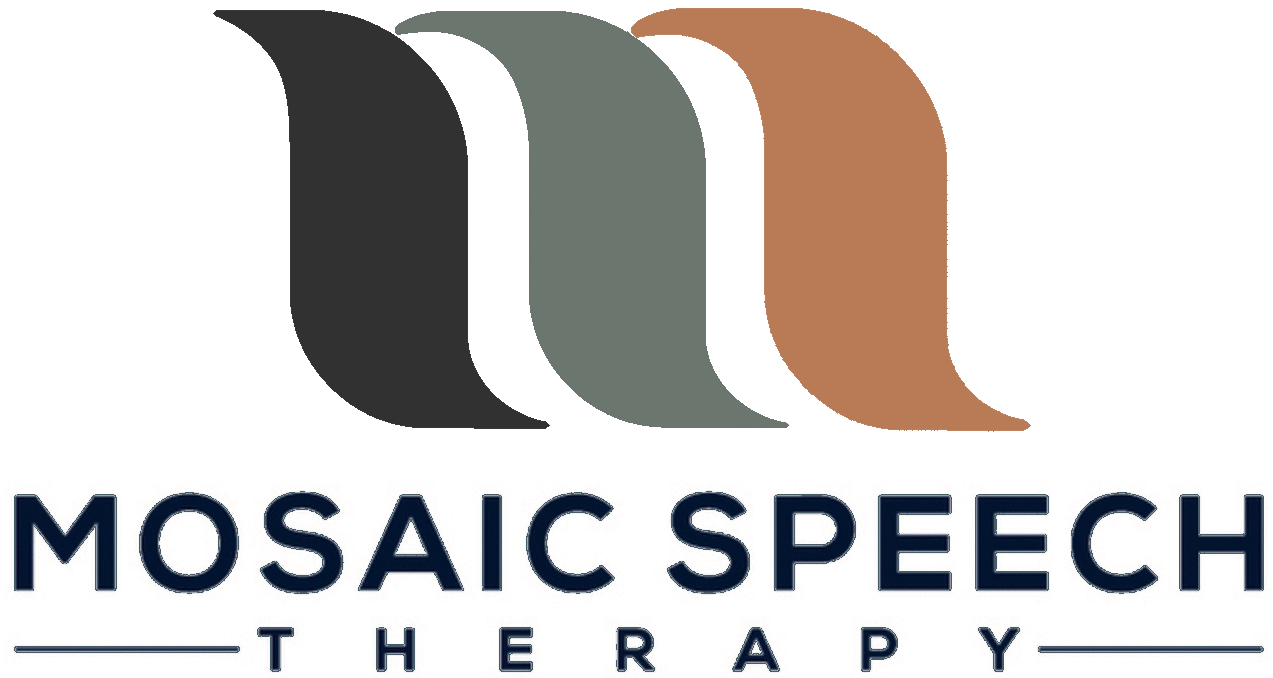SERVICES
We have a variety of services to choose from
Consultation
Do you have questions regarding your child’s communication skills? Are you not sure if your child is developing on-track? Contact us to set up a free phone consultation with an SLP to discuss your concerns and determine next steps.
Assessment
These tools may include formal testing, caregiver or client questionnaires, phone conversations, reviewing previous reports, and clinical observations. A detailed and holistic assessment can provide more information regarding the client’s communication abilities.
Treatment
After evaluating the client’s strengths and skills, the SLP will collaborate with the client and family to create a unique treatment plan with achievable goals. The SLP will use evidence-based techniques combined with the client’s interests to create fun and effective treatment.
Articulation therapy is a method used to teach individuals with speech difficulties how to produce and pronounce the speech sounds correctly.
Receptive language refers to our understanding of language which can be recognized in tasks such as following directions and answering questions. Expressive language refers to our use of language which can be recognized in tasks such as story-telling or describing. We are interested to see how these two key components of language relate to vocabulary, grammar, and the structure of sentences.
Augmentative and alternative communication uses systems/devices to support natural speech. For instance, a small portable amplifier can increase speech volume to help augment clear communication.
A text-to-speech program and a communication board are tools that enable alternative communication.
Phonological awareness refers to the ability to purposefully analyze and manipulate the sound makeup of words, via a range of tasks, such as segmenting and blending sounds together (e.g., ‘cat’ has 3 sounds and is made by /c/- /a/- /t/). Spoken and written language (literacy) are connected with this awareness.
Phonology focuses on how these sounds are organized in our brain.
Movement Music Multiculturalism
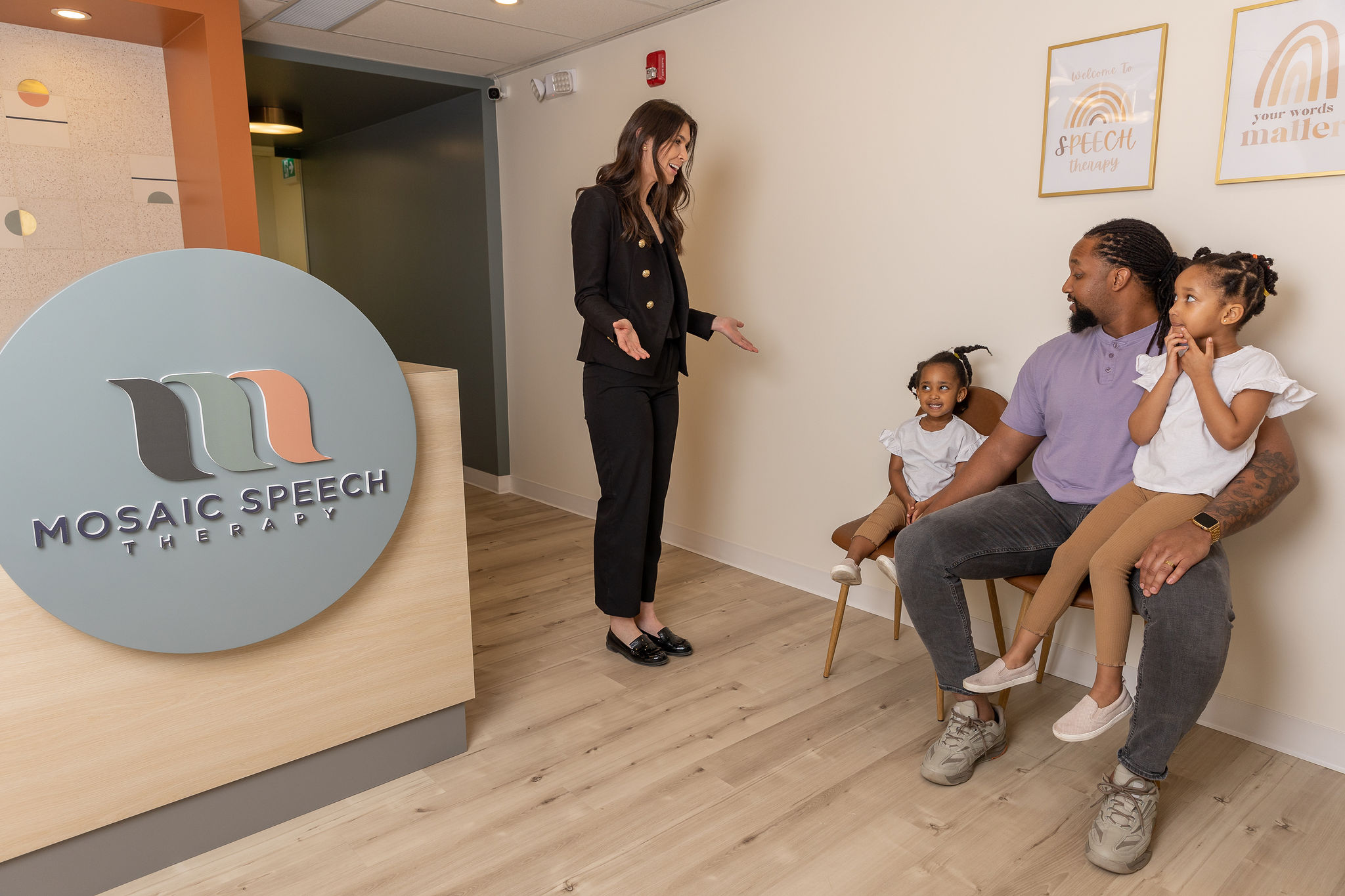
Consultation
- Do you have questions regarding your child’s communication skills? Are you not sure if your child is developing on-track? Contact us to set up a free phone consultation with an SLP to discuss your concerns and determine next steps.
- If your child is currently on a waitlist with AHS or at school, it may be beneficial to consult with a private SLP to advance your child’s speech, language, and communication skills in the meantime.
- Do you and your family speak another language at home and have concerns about your child’s home language development? Give us a call to schedule a consultation.
Assessment
These tools may include formal testing, caregiver or client questionnaires, phone conversations, reviewing previous reports, and clinical observations.
- A detailed and holistic assessment can provide more information regarding the client’s communication abilities.
- Formal assessments and detailed reports may help with accessing funding for the child, such as Program Unit Funding (PUF) & Family Support for Children with Disabilities (FSCD).
- Assessments guide the SLP to develop goals that are meaningful and individualized to the client.
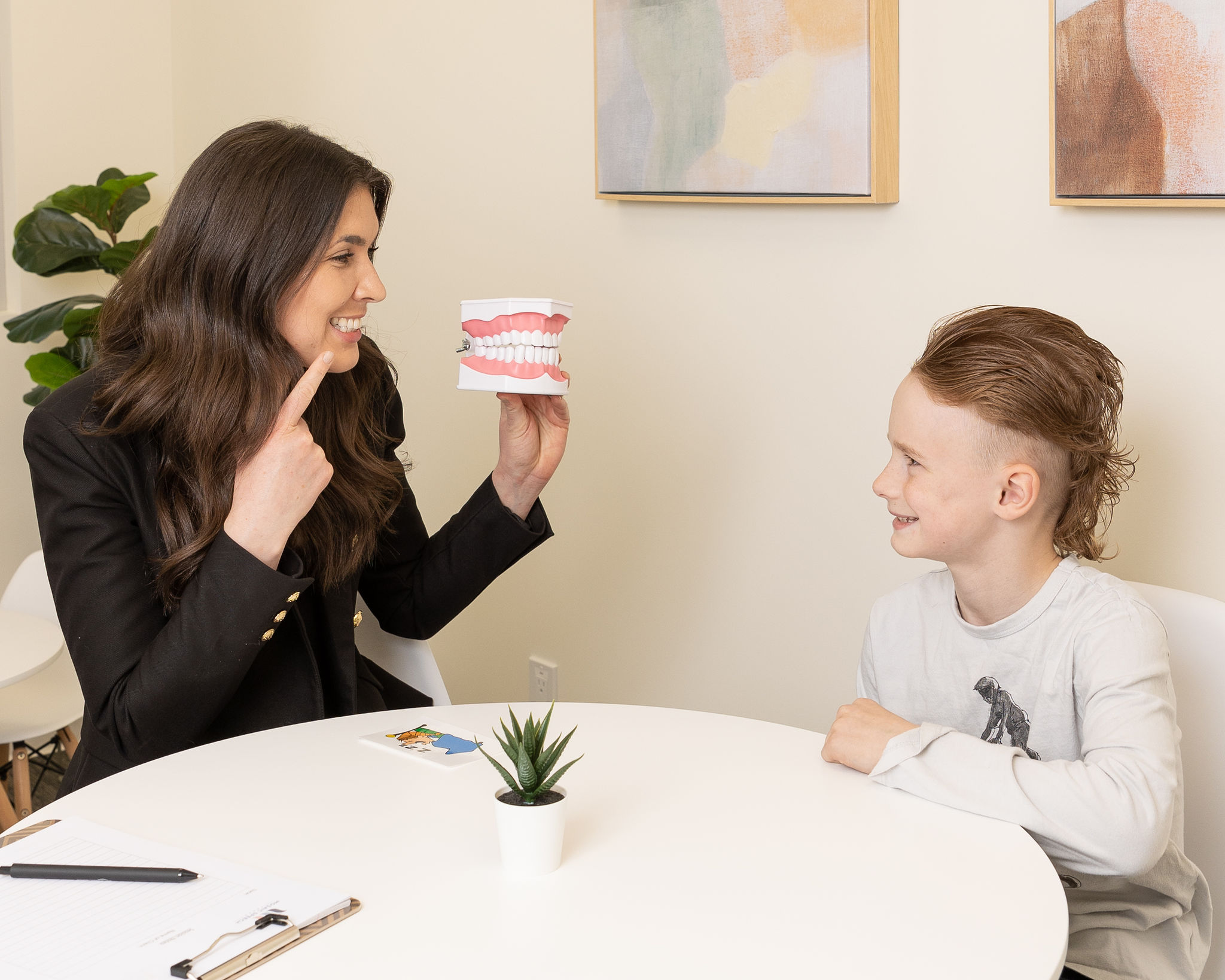
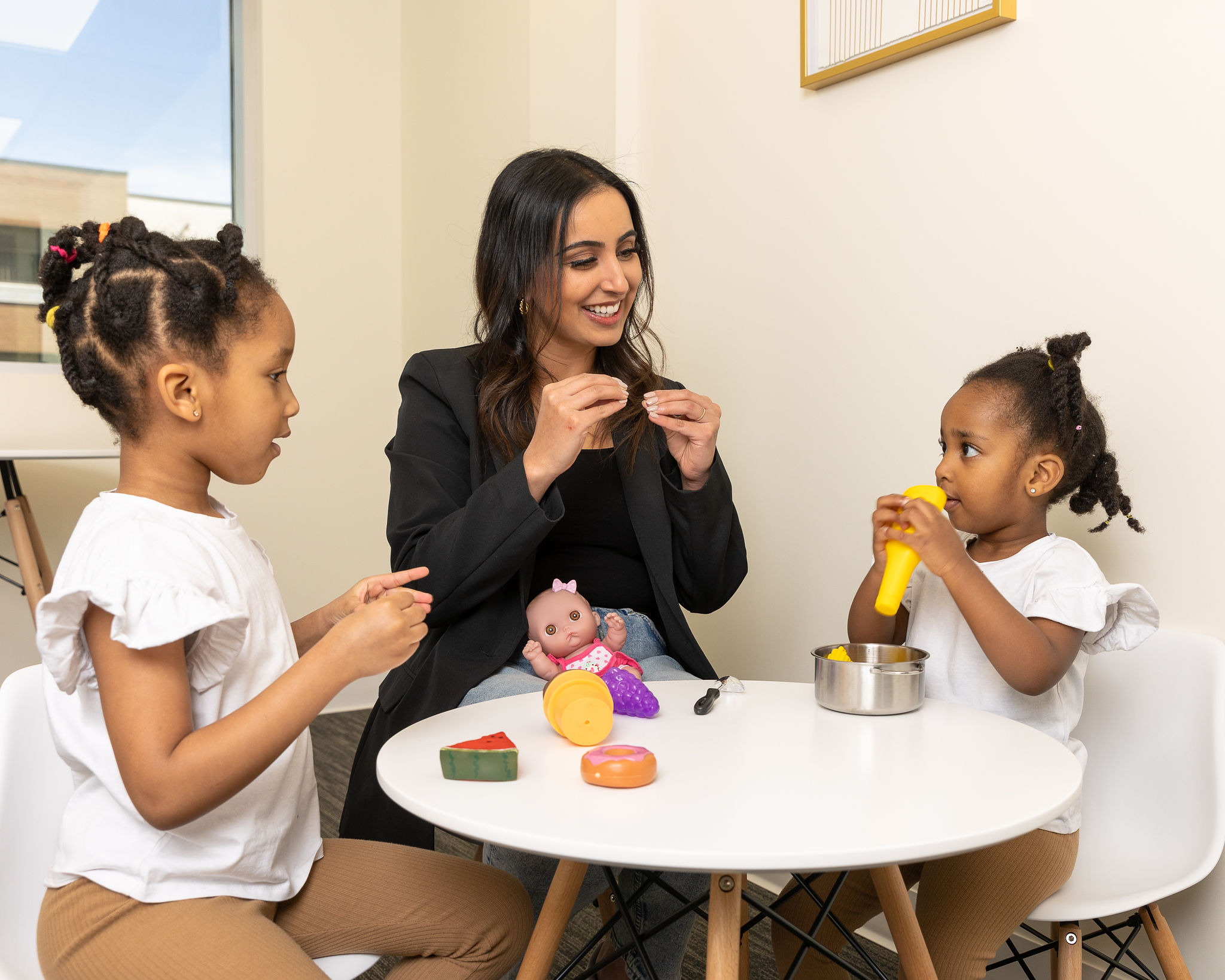
Treatment
These tools may include floor-play, structured activities, crafts, movement, music, and home practice.
After evaluating the client’s strengths and skills, the SLP will collaborate with the client and family to create a unique treatment plan with achievable goals. The SLP will use evidence-based techniques combined with the client’’s interests to create fun and effective treatment.
Building connections and play are very important in Mosaic Speech Therapy’s treatment plans. Our goal is to help families feel supported and confident in practicing the communication strategies they have learned, at home.
Suggestions and activities for home practice will be provided during the last 5-10 minutes of the session. As much as possible, therapy will be based on client interests to encourage participation and motivation.
Families are encouraged to participate and practice strategies during therapy sessions.
- If you have recently received an evaluation from another Speech-Language Pathologist, an assessment may not be necessary.
Teletherapy (providing speech and language therapy on your phone, iPad, or computer) is not a new method. We use technology every day to connect with others. By utilizing technology, a clinician is able to provide consultation, some types of assessment, and therapy through a protected and secure platform. This has opened the door for many children across Canada to access services while living in remote and rural areas. Teletherapy has proven to be an equally engaging and beneficial method for many of our clients.
- Collaboration with the Client’s Team
- Teletherapy Assessment & Treatment
Connecting and collaborating with other members of the client’s team can help with generalizing treatment from home to school. This can include consultation with SLPs at school, occupational therapists, dentists, pediatricians, etc. We can also support daycare staff or teachers, who are willing to learn the strategies that we use in therapy.
Teletherapy (providing speech and language therapy on your phone, iPad, or computer) is not a new method. We use technology every day to connect with others. By utilizing technology, a clinician is able to provide consultation, some types of assessment, and therapy through a protected and secure platform. This has opened the door for many children across Canada to access services while living in remote and rural areas. Teletherapy has proven to be an equally engaging and beneficial method for many of our clients.
- Startles at loud sounds.
- Quiets or smiles when you talk.
- Seems to recognize your voice. Quiets if crying.
- Makes cooing sounds.
- Cries change for different needs.
- Smiles at people.
- Moves her/his eyes in the direction of sounds.
- Responds to changes in your tone of voice.
- Notices toys that make sounds.
- Pays attention to music.
- Coos and babbles when playing alone or with you.
- Makes speech-like babbling sounds, like pa, ba, and mi.
- Giggles and laughs.
- Makes sounds when happy or upset.
- Turns and looks in the direction of sounds.
- Looks when you point.
- Turns when you call her/his name.
- Understands words for common items and people—words like cup, truck, juice, and daddy.
- Starts to respond to simple words and phrases, like “No,” “Come here,” and “Want more?”
- Plays games with you, like peek-a-boo and pat-a-cake.
- Listens to songs and stories for a short time.
- Babbles long strings of sounds, like mimi upup babababa.
- Uses sounds and gestures to get and keep attention.
- Points to objects and shows them to others.
- Uses gestures like waving bye, reaching for “up,” and shaking her/his head no.
- Imitates different speech sounds.
- Says 1 or 2 words, like hi, dog, dada, mama, or uh-oh. This will happen around her/his first birthday, but sounds may not be clear.
- Points to a few body parts when you ask.
- Follows 1-part directions, like “Roll the ball” or “Kiss the baby.”
- Responds to simple questions, like “Who’s that?” or “Where’s your shoe?”
- Listens to simple stories, songs, and rhymes.
- Points to pictures in a book when you name them.
- Uses a lot of new words.
- Uses p, b, m, h, and w in words.
- Starts to name pictures in books.
- Asks questions, like “What’s that?”, “Who’s that?”, and “Where’s kitty?”
- Puts 2 words together, like “more apple,” “no bed,” and “mommy book.”
- Understands opposites, like go–stop, big–little, and up–down.
- Follows 2-part directions, like “Get the spoon and put it on the table.”
- Understands new words quickly.
- Has a word for almost everything.
- Talks about things that are not in the room.
- Uses k, g, f, t, d, and n in words.
- Uses words like in, on, and under.
- Uses two- or three- words to talk about and ask for things.
- People who know your child can understand her/him.
- Asks “Why?”
- Puts 3 words together to talk about things. May repeat some words and sounds
- Responds when you call from another room.
- Understands words for some colors, like red, blue, and green.
- Understands words for some shapes, like circle and square.
- Understands words for family, like brother, grandmother, and aunt.
- Answers simple who, what, and where questions.
- Says rhyming words, like hat–cat.
- Uses pronouns, like I, you, me, we, and they.
- Uses some plural words, like toys, birds, and buses.
- Most people understand what your child says.
- Asks when and how questions.
- Puts 4 words together. May make some mistakes, like “I goed to school.”
- Talks about what happened during the day. Uses about 4 sentences at a time.
- Understands words for order, like first, next, and last.
- Understands words for time, like yesterday, today, and tomorrow.
- Follows longer directions, like “Put your pajamas on, brush your teeth, and then pick out a book.”
- Follows classroom directions, like “Draw a circle on your paper around something you eat.”
- Hears and understands most of what she hears at home and in school.
- Says all speech sounds in words. May make mistakes on sounds that are harder to say, like l, s, r, v, z, ch, sh, and th.
- Responds to “What did you say?”
- Talks without repeating sounds or words most of the time.
- Names letters and numbers.
- Uses sentences that have more than 1 action word, like jump, play, and get.
- May make some mistakes, like “Zach gots 2 video games, but I got one.”
- Tells a short story.
- Keeps a conversation going.
- Talks in different ways, depending on the listener and place. Your child may use short sentences with younger children. He may talk louder outside than inside.
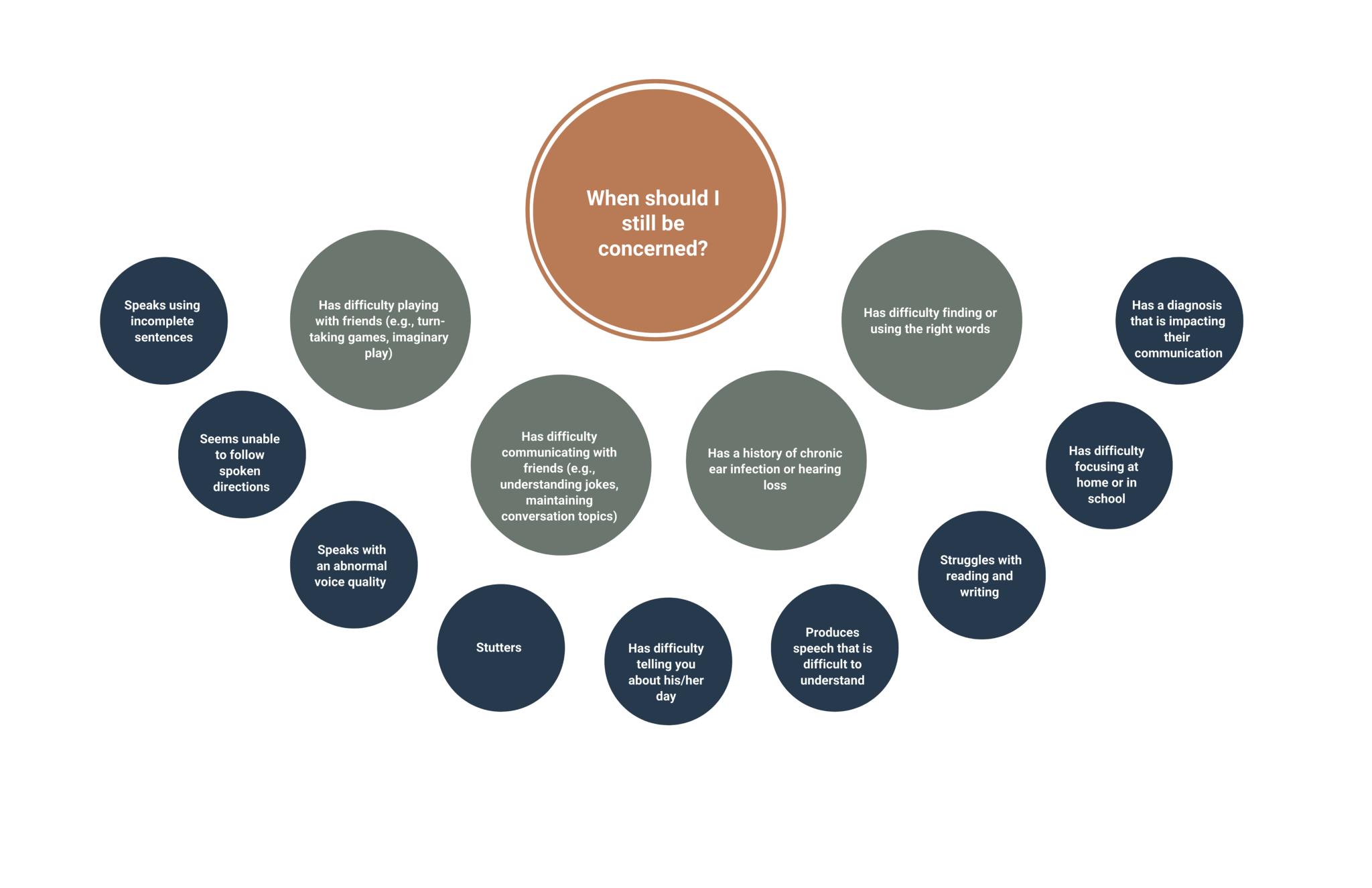
When should I still be concerned?
My child:
- Speaks using incomplete sentences.
- Seems unable to follow spoken directions.
- Has difficulty playing with friends (e.g., turn-taking games, imaginary play).
- Has difficulty communicating with friends (e.g., understanding jokes, maintaining conversation topics).
- Speaks with an abnormal voice quality.
- Stutters.
- Has a history of chronic ear infection or hearing loss.
- Has difficulty finding or using the right words.
- Has difficulty telling you about his/her day.
- Produces speech that is difficult to understand.
- Struggles with reading and writing.
- Has difficulty focusing at home or in school.
- Has a diagnosis that is impacting their communication.
